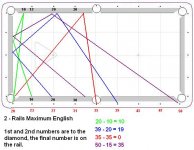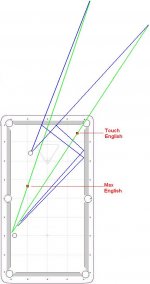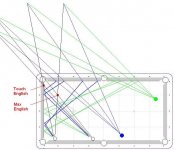Colin you are apiece of work for sure

I'm glad to see there is someone out there as fanatical as I am when it comes to color coded kick diagrams.
On my home(pool room) practice table I color coded all the three rail kick track lines starting from Diamonds 8,7 and 6 on the short rail all the way down to diamonds 5,4,3,2,1 on the long rail.I could alter speeds and 3 rail kick to the opposite corner I started from and also come 1, 2 and 3 diamonds short(from some of the starting posistions) when I added speed.Of course everything was color coded and memorized. On my home practice table I'm a kicking machine for sure.
Unfortunatley track lines change when you go to another table or can really change when you go to another pool hall with different equipment. The track lines are pretty consistent on most tables when contacting the 3rd rail. It's when you come off the third rail where the track lines change and in most cases things shorten up.With a few experimental kicks one can see the differences and make the adjustments , so your color coding is not done in vain.
Take care Colin and keep up the good work.
RJ


